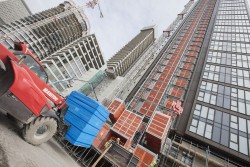Richard Tonkinson, executive director of bathroom pod manufacturer Offsite Solutions, offers some practical advice for specifying factory-built bathrooms
The shift towards offsite across the construction industry is being driven by the shortage of skilled labour, compounded by Brexit; issues with consistent quality, and the construction industry's poor record of on time and on budget delivery. The publication of reports such as the recent House of Lords committee review into offsite manufacture has further highlighted the need to move more work offsite and factory-built bathrooms.
There is now unprecedented demand for bathroom pods – for high-end apartment schemes, mixed-use developments, social housing, build-to-rent, student accommodation, healthcare, care homes and hotels. More contractors and developers are taking an offsite approach to bathroom construction. Reducing the number of activities and trades on-site results in significant programme savings, quality improvements and waste reductions of up to 50%.
What are the different pod types?
Steel-framed pods: Allow traditional ceramic-tiled finishes and a high level of design flexibility. Applications include large-scale apartments, student residences and hotels.
New innovations in pod technology:
Hybrid concrete/steel pods: A concrete base and steel-framed walls for high specification wet rooms and luxury bathrooms, with less weight than full concrete pods.
Demountable GRP pods: A sectional structure for projects with restricted access. Panels can be sized for access via the main entrance, lift shafts or façade openings for refurbishments.
Hybrid GRP pods: An enhanced finish and improved aesthetics for GRP pods, such as ceramic tiling, back-painted glass panels and recesses. Applications include build-to-rent and premium student accommodation schemes.
Floorless pods: For projects where a continuous level floor finish is required throughout a building or for schemes requiring bathroom floors with no threshold and where a slab recess is not feasible.
How are pods installed?
Factory-built bathrooms are delivered on a supply-only basis and the main contractor organises installation via the M&E contractor. The exception is demountable pods, where the manufacturer would undertake installation and assembly.
Ten GRP pods can be delivered to site in two hours – or six to eight steel-framed pods. It can take around 80 hours for a bathroom to be built onsite requiring around seven different trades and 10-15 operations plus drying times. A pod can be manufactured in 14 hours with just one supplier, which means improved quality, reduced defects and remedial works.
Key specification considerations
Consider access: Accommodate pod installation in the build-up of walls and floors. Take account of access for delivery of the pods to site, particularly on constrained sites.
Look at economies of scale: Standardised designs with minimal variations allow cost savings and time efficiencies by using the repetition of the production process. A good manufacturer will have an extensive library of pod designs.
Pods can be bespoke, but specifiers need to allow for modelling, prototyping, production engineering, machine programming, production line set-up – and the manufacture of GRP moulds.
How to integrate pods with building services
Connections to services are made externally so access should be allowed as part of the installation process.
A good manufacturer will design the pods to facilitate installation, using for example mechanically fitted pan connectors and the option of pre-wired junction boxes to reduce work on site.
Pod installation
The floor slab should be flat and level to +/- 10mm tolerance for accurate installation.
The base frame for the pod with lifting lugs should also act as a lifting frame with welds that have been certified by a structural engineer for the required loads.
Ensure the perimeter base frame is correctly sized to have the structural rigidity to transport and lift the pod and to minimise any flexing of the floor or floor damage could result.
Manufacture of lifting frames should be project-specific and certified for that type of pod. Each frame and pod type should be tested for safe and level lifting. A method statement and test certificates should be provided to the contractor in accordance with CDM regulations. The use of generic frames, which may be non-compliant, is not recommended.
What should you consider in the design of the bathrooms?
To optimise efficiency, specifiers should rationalise the number of design types in size and shape, and variations, such as left and right-hand versions, as far as possible.
Natural materials such as marble and granite do not transport well, and these finishes are not uniform so the typical high tolerances that a pod manufacturer will work to may not be possible.
How will the bathroom pod be constructed to ensure longevity?
Steel-framed pods: Steel-framed pods should have a double skin with timber and plasterboard in cementitious board construction to Lifetime Homes standards. This will facilitate tile replacement.
The entire walls and floor to the wet area should be fully tanked – not just half of the shower wall. All exposed external plasterboard edge joints should also be tanked.
GRP pods: GRP pods should have robust wall detailing with encapsulated honeycomb polypropylene. Be aware that cheaper alternatives such as cardboard can be susceptible to delamination.
A panelised system should be used to create vertical walls and 90° corners. This avoids tapered walls for improved aesthetics and to allow easier integration and the use of standard door sets without further work onsite.
What factory testing is carried out?
Stringent air and water tests should be carried out on every pod at pre-calibrated static testing stations in the factory. We recommend every fifth pod undergoes a comprehensive functionality test. All outlets (taps, shower and toilet) should have water passed through.
The completed electrical installation should undergo a full function and resistance test carried out by NICEIC-approved electricians.
Test certificates should be provided for both electrics and plumbing. We recommend this is added to your specification.
To attend a CPD seminar to find out more about factory-built bathrooms, visit www.offsitesolutions.com/CPD
Richard Tonkinson - Executive director - Offsite Solutions - www.offsitesolutions.com









